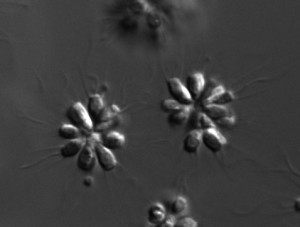![]() One of the most fascinating leaps in evolution is the transition from unicellular to multicellular organisms. How individual free living cells joined forces to create more complex multicellular organisms is still not well understood. For metazoans, this transition is thought to have occurred through a colonial intermediate that was composed of cells similar to choanoflagellates. In an article published today in Genome Biology, Fairclough et al. use choanoflagellates to gain insight into this evolutionary transition.
One of the most fascinating leaps in evolution is the transition from unicellular to multicellular organisms. How individual free living cells joined forces to create more complex multicellular organisms is still not well understood. For metazoans, this transition is thought to have occurred through a colonial intermediate that was composed of cells similar to choanoflagellates. In an article published today in Genome Biology, Fairclough et al. use choanoflagellates to gain insight into this evolutionary transition.
Choanoflagellates are free-living unicellular organisms and are the closest living relatives of metazoans. The similarity between these organisms and the proposed ancestor of metazoans has made them attractive to scientists interested in studying this evolutionary shift. Indeed, a previous study of the genome of one choanoflagellate, Monosiga brevicollis, has already provided insight into the likely genetic composition of the metazoan ancestor.
In order to gain further insight into the makeup of the metazoan ancestor as well as the evolution of multicellularity, Fairclough et al. sequenced the genome of Salpingoeca rosetta, another choanoflagellate, which is included in the article published in Genome Biology today. In this study, the authors compare the S.rosetta genome with the genomes of metazoans and metazoan outgroups including that of the choanoflagellate M.brevicollis. This analysis has strengthened previous observations made from the study of M.brevicollis, such as the finding that the evolution of tyrosine kinases occurred prior to the origin of metazoans, as well as increasing the number of metazoan genes inferred to have been present before the evolution of animals.
This analysis has also shown that while the last common ancestor of choanoflagellates and metazoans had a gene rich genome, which already contained many genes known to regulate development in animals, it also underwent notable gene loss and gain prior to the evolution of metazoans.

In contrast to M.brevicollis, which is strictly unicellular, S.rosetta has both unicellular and colonial life stages, and the rosette shaped colonies produced by these individuals evoke the hypothesized colonial intermediate. Interestingly, previous research has shown that these colonies form through cell division, rather than through aggregation.
The existence of both single-and multicellular life stages in S.rosetta has allowed Fairclough et al. to identify genes potentially important in the regulation of the transition from unicellular to multicellular forms, through profiling transcriptional changes that occur in these different life stages. This analysis has illuminated several metazoan genes that may have been important in the evolution of multicellularity, such as the septins.
This analysis has provided a greater understanding of our distant ancestor and helped shed more light on animal evolution, and in particular the evolution of multicellularity.
Latest posts by Laura Fulford (see all)
- Two genomes are better than one: insights into the biology of the parasitic nematode Haemonchus contortus - 28th August 2013
- Genome Biology at Non-coding RNA, epigenetics and transgenerational inheritance 2013 - 23rd April 2013
- From single cells to complex life; understanding the origins of animal multicellularity - 18th February 2013
[…] biology flavor to it, exemplified by Nicole King's and Brendan Loftus's studies on the origins of complex life, using the choanoflagellate Salpingoeca rosetta and the amoeba Acanthamoeba castellanii as living […]